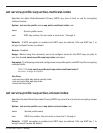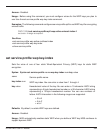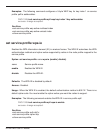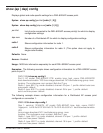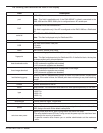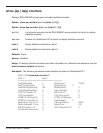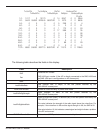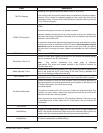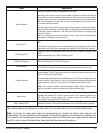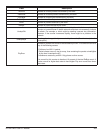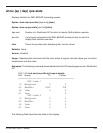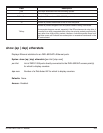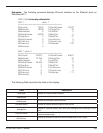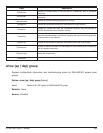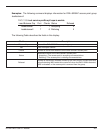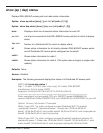
D-Link DWS-1008 CLI Manual 401
Field Description
User Sessions
Number of clients currently associated with the radio.
Generally, this counter is equal to the number of sessions listed for the radio in
show sessions output. However, the counter can differ from the counter in show
sessions output if a client is associated with the radio but has not yet completed
802.1X authentication. In this case, the client is counted by this counter but not
in the show sessions output.
Although there is no specific normal range for this counter, a high or low number
relative to other radios can mean the radio is underutilized or overutilized relative
to the other radios. (However, if the clients are VoIP phones, a relatively high
number of clients
does not necessarily mean overutilization since voice clients consume less
bandwidth on average than data clients.)
MIC Error Ct
Number of times the radio received a TKIP-encrypted frame with an invalid
MIC.
Normally, the value of this counter should always be 0. If the value is not 0, check
the system log for MIC error messages and contact D-Link Technical Support.
TKIP Decrypt Err
Number of times a decryption error occurred with a packet encrypted with
TKIP.
(See the description for CCMP Pkt Decrypt Err.)
CCMP Pkt Replays
Number of CCMP packets that were resent to the AP by a client.
(See the description for TKIP Pkt Replays.)
RadioResets
Number of times the radio has been reset. Generally, a reset occurs as a result
of RF noise. It is normal for this counter to increment a few times per day.
Transmit Retries
Number of times the radio retransmitted a unicast packet because it was not
acknowledged. The AP uses this counter to adjust the transmit data rate for a
client, in order to minimize retries.
The ratio of transmit retries to transmitted packets (TxUniPkt) indicates the overall
transmit quality. A ratio of about 1 retry to 10 transmitted packets indicates good
transmit quality. A ratio of 3 or more to 10 indicates poor transmit quality.
Note: This counter includes unacknowledged probes. Some clients do not
respond to probes, which can make this counter artificially high.
Noise Floor
Received signal strength at which the AP can no longer distinguish 802.11
packets from ambient RF noise. A value around -90 or higher is good for an
802.11b/g radio. A value around -80 or higher is good for an 802.11a radio.
Values near 0 can indicate RF interference.
802.3 Packet Rx Ct
Number of raw 802.3 packets received by the radio. These are LocalTalk
(AppleTalk) frames. This counter increments only if LocalTalk traffic is present.
The counters above are global for all data rates. The counters below are for individual data rates.
Note: If counters for lower data rates are incrementing but counters for higher data rates are not
incrementing, this can indicate poor throughput. The poor throughput can be caused by interference.
If the cause is not interference or the interference cannot be eliminated, you might need to relocate
the AP in order to use the higher data rates and therefore improve throughput.



